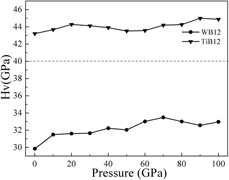Crossref Citations
This article has been cited by the following publications. This list is generated based on data provided by
Crossref.
Zhang, Xudong
Dong, Tianhui
Ma, He
Li, Dongzhi
Ying, Caihong
Liu, Cong
and
Wang, Feng
2020.
A first principles investigation on the influence of transition-metal elements on the structural, mechanical, and anisotropic properties of CaM2Al20 intermetallics.
Journal of Molecular Graphics and Modelling,
Vol. 96,
Issue. ,
p.
107509.
Mai, Ziyi
Zhang, Xudong
Liu, Yiting
Yu, Hui
and
Wang, Feng
2020.
Insight into the structure dependence on physical properties of the high temperature ceramics TaB2 boride.
Vacuum,
Vol. 177,
Issue. ,
p.
109427.
Pan, Yong
Pu, Delin
and
Liu, Gaihua
2020.
Influence of Mo concentration on the structure, mechanical and thermodynamic properties of Mo–Al compounds from first-principles calculations.
Vacuum,
Vol. 175,
Issue. ,
p.
109291.
Chen, Jing
Zhang, Xudong
Zhu, Shiyu
Ma, He
Li, Xiaoyu
Yu, Hui
and
Wang, Feng
2020.
Elastic anisotropy and thermodynamics properties of BiCu2PO6, BiZn2PO6 and BiPb2PO6 ceramics materials from first-principles calculations.
Ceramics International,
Vol. 46,
Issue. 7,
p.
8575.
Pan, Yong
2020.
The structural, mechanical and thermodynamic properties of the orthorhombic TMAl (TM=Ti, Y, Zr and Hf) aluminides from first-principles calculations.
Vacuum,
Vol. 181,
Issue. ,
p.
109742.
Hossain, Md. Mukter
Ali, Md. Ashraf
Uddin, Md. Mohi
Naqib, Saleh Hasan
and
Islam, A. K. M. Azharul
2021.
Newly Synthesized Three-Dimensional Boron-Rich Chalcogenides B12X (X = S and Se): Theoretical Characterization of the Physical Properties for Optoelectronic and Mechanical Applications.
ACS Omega,
Vol. 6,
Issue. 49,
p.
33899.
Chen, Meng-Ru
Tian, Jun-Hong
Song, Ting
Liu, Zi-Jiang
and
Sun, Xiao-Wei
2022.
Effect of Sc, V, Zr, and Hf doping on the mechanical properties of TiB3 under high pressure.
Applied Physics A,
Vol. 128,
Issue. 4,
Yan, Yaqiong
Wei, Qun
Yan, Haiyan
Wu, Zhenhua
and
Zhang, Meiguang
2022.
Stability and electronic properties of five new ternary tantalum carbonitrides.
Computational Materials Science,
Vol. 214,
Issue. ,
p.
111728.
Wang, Yu
Wu, Yue-Dong
and
Zhang, Guo-Hua
2022.
Boronation reaction between molybdenum or tungsten powder and boron carbide in aluminium melt.
International Journal of Refractory Metals and Hard Materials,
Vol. 105,
Issue. ,
p.
105813.
Zhang, MaoLing
Yin, Shi
Chang, Jing
and
Ge, NiNa
2022.
Structural, mechanical, electronic and bonding properties of TMB2(TM = Y, Sc, Ti) under pressure: a DFT investigation.
Philosophical Magazine,
Vol. 102,
Issue. 12,
p.
1136.
Cui, Zhi
Yang, Qiuping
Qu, Xin
Zhang, Xiaohua
Liu, Yong
and
Yang, Guochun
2022.
A superconducting boron allotrope featuring anticlinal pentapyramids.
Journal of Materials Chemistry C,
Vol. 10,
Issue. 2,
p.
672.
Wang, Yu
Liu, Jun-Ru
Li, Zhi-Bo
and
Zhang, Guo-Hua
2022.
Preparations of Molybdenum/Tungsten Borides by Boriding Molybdenum/Tungsten Powder with Boron Nitride.
JOM,
Vol. 74,
Issue. 10,
p.
3869.
Han, Shuai
Yu, Linchao
Liu, Yunxian
Zhao, Bo
Wang, Chao
Chen, Xin
Zhang, Yongsheng
Yu, Runze
and
Liu, Xiaobing
2023.
Clathrate‐Like Alkali and Alkaline‐Earth Metal Borides: A New Family of Superconductors with Superior Hardness.
Advanced Functional Materials,
Vol. 33,
Issue. 14,
Yu, Ende
and
Pan, Yong
2023.
First-principles prediction of structural, electronic and optical properties of alkali metals AM4BN3H10 hydrides.
International Journal of Hydrogen Energy,
Vol. 48,
Issue. 39,
p.
14785.
Zhao, Bo
Wang, Lu
Tao, Qiang
and
Zhu, Pinwen
2023.
The structure and multifunctionality of high-boron transition metal borides
*
.
Journal of Physics: Condensed Matter,
Vol. 35,
Issue. 17,
p.
173001.
Pan, Yong
2023.
Effects of Cu, Ag and Au on electronic and optical properties of α-Ga2O3 oxide according to first-principles calculations.
Journal of Physics and Chemistry of Solids,
Vol. 174,
Issue. ,
p.
111152.
Xiao, ChenDa
Xu, Min
Feng, ShiQuan
Deng, FeiRan
Huang, Yi
Miao, Feng
and
Xiang, LingWei
2023.
First-principle calculations on doped CrB4.
Canadian Journal of Physics,
Vol. 101,
Issue. 8,
p.
397.
Pan, Yong
and
Zhu, Jiaxin
2024.
Enhancing the Vickers hardness of Yttrium borides through bond optimization.
Materials Today Communications,
Vol. 38,
Issue. ,
p.
108428.
Wang, Xiaoming
Ma, He
Zhang, Xudong
Chen, Lijia
Wu, Hao
and
Chen, Shiyi
2024.
First-principles prediction on the structural stability, electronic, optical and mechanical properties of TiBC, Ti6Si2B and Ti6Ge2B.
Physica B: Condensed Matter,
Vol. 683,
Issue. ,
p.
415928.
Chen, Meng-Ru
Dou, Xi-Long
Song, Ting
Yan, Zhi-Peng
and
Sun, Xiao-Wei
2024.
A novel superhard phase of TiB3 predicted by first-principles calculation.
Results in Physics,
Vol. 61,
Issue. ,
p.
107779.





